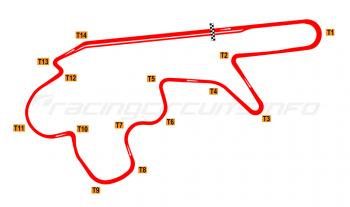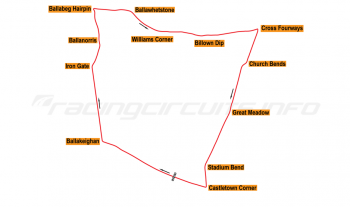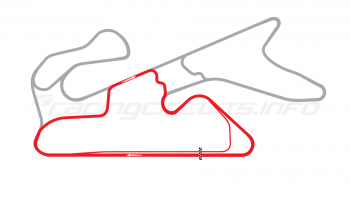Waterford Hills
Circuit Overview
Waterford Hills is another often-overlooked gem of the American road racing scene, a 1.5 mile road course on the grounds of the Oakland Hills Sportsmen's Club, located just outside of Detroit, Michigan.
With its hilly layout affording good views for spectators, it is renowned as a driver’s track, thanks to its undulating sequence of low speed but undulating corners, with blind crests, and cambered corners packed into its short length.
Unchanged in layout since its founding in 1958, the track has become a home for varied programme of SCCA regional and club racing, mainly hosted by the Sportsmen’s Club itself, as well as a popular vintage race meeting.
Circuit History
The Oakland County Sportsmen's Club (OCSC) was found in 1943 as private not-for-profit organisation, offering its members the opportunity to pursue a range of outdoor recreational activities. Set in more than 200 acres of land in Independence Township, the club’s facilities regularly provide members and guests with the opportunity for both indoor and outdoor archery, pistol ranges, 25, 50 & 100 yard rifle ranges, muzzleloading, skeet and trap shotgun ranges.
The origins of motorsport at the facility began in the spring of 1958, when OCSC members Bob Gubbins, Harry Barnes and Les Smith were attending another car club's meeting and struck up a conversation with driving enthusiast Ed Lawrence. Gubbins had the idea to put on a gymkhana on an unused 80 acres of land at OCSC. Together they put together a plan and Gubbins and Barnes approached the OCSC board to pitch the idea.
At the time the OCSC was looking for ways to increase membership, so the idea of capturing the burgeoning interest in sportscar racing seemed attractive. The board agreed to rent the 80 acres to the Michigan Sports Car Club for $50, to enable the creation of a one-lane dirt course on the property. A grant from the club allowed for bulldozers to come in and begin the grading work.
Gymkhana events pave the way - for paving!
The first MSCC gymkhana event was held on a temporary, one lane 4/10 mile course on May 4, 1958, with a luncheon held at the clubhouse at the conclusion of the trials. After that first event, the track was lengthened to 1.3 miles, graded and treated with chloride in an attempt to control dust. On June 8, the Corvette Club held their first event drawing 43 entrants and a few weeks later the first trials were held on June 28 on the new "Field Trials Course".
These first steps into motorsport proved successful enough to convince OCSC President Ed Spicer that there was a further opportunity to bolster the Club’s membership through the addition of an in-house sportscar club and making a permanent course for members to use.
So it was that Gubbins set out organising three additional gymkhana events under the OCSC’s auspices. Called the Pioneer Time Trials, they were scheduled for the summer and autumn of 1958. A specific sportscar committee was formed to regulate use of the new course and a now famous "Dear Sports Car Enthusiast'' letter was sent out to hundreds of people encouraging them to join OCSC with the vague promise of a paved course sometime in the future.
The first of the Pioneer Time Trials were held on August 9-10, 1958, attracting 60 entrants and growing club membership to over 80. While a success in sporting terms, the event drew the ire of the neighbourhood adjacent to the track, as the dirt surface threw billowing clouds of dust into the air, causing numerous complaints. It was clear that the chloride and clay treatments were insufficient to solve the problem, so the second time trials scheduled for September 13-14 were quickly cancelled to allow time for a better plan to be found.
The only solution seemed to be to accelerate the programme to pave the course. To enable this, a corporation was hastily formed, with Barnes as the President and Gubbins seated as the Vice-President. To fund the paving, letters were sent to 4,000 area enthusiasts, offering notes of $250, $500 and $1,000 to secure a loan for the asphalting works. Meanwhile, the OCSC leased the land to the newly-formed Road Racing Corporation until October 1962.
Paved course opens in double quick time
The gambit worked and by the final weekend of September 1958, nine benefactors had stumped up the necessary $12,000 to enable paving to begin. It seemed implausible to some that it could be completed before winter, however, that didn’t account for the persistence and enthusiasm of the members of the OCSRRC. They banded together such that paving on a one-lane, 12 feet wide and 7510 feet long course began on October 9 and wrapped up the next day by 4pm!
A day later, the third Pioneer Time Trials were staged on the still-warm pavement, with additional runs allowed due to the cancellation of the previous event. It was an excellent of example of determination succeeding against the odds.
In January 1959 the track was officially named ‘Waterford Hills’ and opened up to all comers for the first three weekends of each month, offering four laps for $1. The track continued to develop, with Harry Barnes building an 8x8 "Control and Observation Tower" on the infield, across from the current start stand. Electric was run to the tower which enabled it to power communications and a PA system.
Numerous other fundraising initiatives were also undertaken and three further batches of ‘Dear Enthusiast’ letters were mailed out to prospective supporters. They were usually accompanied by an invite to a time trial being held at Waterford Hills. Several driver's schools were also held at the track during the winter months.
Despite these efforts, the nine original members who had guaranteed payment for the paving had to assist with the $1000 per month loan payment. Only 91 members had paid their $5 dues which were due the end of January of 1959.
A blow to the Road Racing Corporation came in March of 1959 when Ed Lawrence was killed during final practice for the Sebring 12 Hours, when his Maserati left the road at the hairpin, rolling several times before bursting into flames. It was a particular blow to all at the OCSRRC to lose one of its main instigators, just as the new track was gathering momentum. Ed's wife Joan (now always referred to at the Club as Joan Lawrence Voltmer) remained an active participant in the club for many years and was named an honorary non-voting member of the road racing board.
Despite the tragedy, the track continued to innovate introducing a new challenge in the summer to try and make up for the fact that true road racing was near impossible due to the narrow width of the course. The ‘Australian Pursuit Race’ concept was modified to suit Waterford Hills’ course conditions. Since cars could not pass, they were started out at time intervals. When a car "caught" the car it was pursuing by coming within one second of it, the "caught" car was flagged off the course and the pursuer was free to chase another.
Track widening gets a mystery boost
It was still clear that if the track was truly to succeed it would need its second lane paving, doubling the width and allowing side-by-side racing. A plan was devised to raise $15,000 by offering life memberships as a way to finance the paving. Denominations of $100, $250, $500 and $1000 were proffered as investments to be repaid within 12 months. However, in September 1959 an anonymous donor (now known to be Alan Brengle) came forward to put up securities to secure a loan to pay for the paving.
In a repeat of the previous year’s herculean efforts, the OCSRRC had five weeks to pull off the repaving project, ahead of the new circuit’s inaugural race meeting on October 10. Once again they took it down to the wire with the paving being completed on October 9, 1959. Track width was now 24 feet on the straights and 30 feet in the corners. The club members themselves assisted, erecting a 2000 ft board fence along the back straight to minimise noise disruption to the neighbouring properties. Telephone lines, spectator fencing, the pit and paddock area, land clearing, and many other projects were accomplished on weekends by willing volunteer workers.
Their efforts paid off when, on October 10 and 11, the Waterford Hills Inaugural Races were held. The races were named the Ed Lawrence Memorial Races. Bob Clift, racing a C Modified Corvette, won the first Ed Lawrence Memorial Trophy. Today, the Big Bore Feature Race of the last race weekend of each season has come to be known as the Ed Lawrence Memorial Race, with the winner taking the trophy.
Stirling Moss gives his approval
Into the 1960s and the track continued to develop, as safety innovations started to come to the forefront. Corner stations now had communications, a PA system had been installed, privacy fencing installed and some primitive guard rail had been installed around parts of the course. Not that there weren’t still some usual hazards - the area known as The Swamp was rather wetter than its name suggested, forcing a diver to be stationed in a rubber raft during races in case an errant car went of course… Thankfully today this is not needed as the area has much better drainage!
One of the big highlights of 1961 was the visit Sir Stirling Moss on October 1. The Formula One ace had been competing in the first Canadian Grand Prix at Mosport the day before and accepted an invite to visit Waterford Hills prior to a lecture he was giving at the Masonic Temple that night. Track officials provided Moss with a brand new Chrysler 300 to sample the course, expecting him to complete three sedate laps around the course to salute fans. Evidently Moss rather enjoyed himself and had other ideas, pressing on to test the. limits of the car and having to be flagged off the course after 30 minutes!
In an address to the paddock following his touring laps, Stirling was quoted as saying, "If you can go fast at Waterford, then you can go fast anywhere."
Continued improvements as decades pass
As the decade wore one, further improvements to the track kept pace with the increased interest it was generating. In May of 1963, plans were announced to build 100 bleacher seats with tickets for those seats to be sold at a cost of $1. If the seats sold out, there were plans to build an additional 500 seats. Elsewhere, the swamp paddock area was graded for additional paddock space due to large entry counts. Sadly, in August that year a flagman was injured during a crash and so plans were immediately announced to add chain link fence around the entire track for the safety of workers and spectators.
However, there was potential trouble on the horizon from the surrounding neighbours of the property, who were becoming increasingly vocal with their displeasure at the frequent use of the facilities and the associated noise nuisance. There was talk of a potential lawsuit, so in spring 1964, the OCSC and OCSRRC entered into a consent judgment with some of their neighbours, which had the effect of greatly reducing the time of year, number of days and hours of operation which the track could be used. Strict monitoring of these rules continues to the present day.
The first phase of a new tower construction also began in 1964. It included restrooms, a snack bar and storage. There was also a proposed catwalk for the starter from the north end of the building. Future plans included a 2nd and 3rd floor for timing and scoring and race control. This facility was burned by vandals in 1981 but a replacement building was soon under construction under the supervision of veteran member Don Burry. It was later named the Don Burry Tower.
On track, the action continued to please and the August 1964 SCCA race resulted in a record 4,400 spectators over the course of the weekend. There is a close relationship between the Waterford club and the SCCA; in the early 1960s, SCCA classifications were adopted by the track so members could compete in events sponsored by each, an arrangement that remains in place today. Waterford racing licenses continue to be accepted at Midwest SCCA Regional races.
Plans were put in place for a track widening programme in 1965, which aimed to add another 6 feet but for reasons unclear this was never implemented, despite the funds having been raised. Indeed, the track still remains at the same width all these years later.
Safety improvements continued with plans for even more guard rail. Standing starts were also phased out at the end of the decade, in line with moves from the SCCA. In October of 1969, a constitution was proposed to unite the corporate board and the club board. These were the first steps towards renaming the club and changing its corporate status to non-profit.
Over the years safety provisions have been upgraded, mostly by volunteer effort and donated professional services. There are now gravel traps at almost every corner. A larger run off area was constructed at Turn One in the mid-2000s. This involved moving and reinstalling fences and guardrails and smoothing the ground off the end of the turn. A member of the club, a contractor, sent crews with grading equipment to do the contouring and volunteers moved and rebuilt the barriers.
For many years, one of the challenges of the track was the differing grip levels offered by the concrete patches which lined many of the key turns. A course repave in 2019 removed these, leaving a complete asphalt surface all the way round, but not diminishing the overall challenge of lapping consistently at speed in any way.
Waterford Hills today
The circuit continues to be member-owned and proudly declares itself ‘the people’s track’. It’s hard to disagree with that assessment. Races are run in accordance with SCCA competition rules and all cars must pass SCCA technical inspection, buy the friendliness of all those involved puts many other circuits to shame. That welcoming attitude is reflected in the wide variety of machinery that can be seen on track; just about everything you can imagine from Corvettes, Mustangs, BMWs, Miatas and Porsches, to open wheel single seaters and screaming mid-engine sports racers.
The track is also open to the public on designated Open Track Days. Bring your favourite street car, or partially race prepped street car out and you can try your hand at lapping the track. All you need is a valid driver's license, seat belts, and a helmet.
Every spring the track also holds an SCCA-accredited drivers school to bring in a new generation of drivers to enjoying racing at the facility.
Much of this track history has been adapted from the excellent research thesis by Richard Ranville Jr.: ‘Amateur Road Racing in Michigan: Three Institutions’ which is reproduced in full on the Waterford Hills website.
Jump onboard
Circuit info
- Waterford Hills Road Racing, Waterford Road, Clarkston, MI 48346-3453, USA
- +1 248 623 0070
- Official website
Rate This Circuit
Votes: 1453
Plan a visit
Get your race tickets!
Brought to you with: 
We've teamed up with Motorsports Tickets to bring you the best deals for Formula One, MotoGP, Le Mans and more.




















